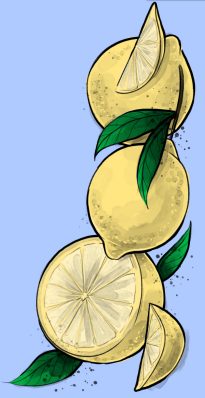A lot of things simply don’t grow in Vermont. Magnolias, figs, azaleas, and avocados don’t have what is popularly known here as a snowball’s chance in hell. We’re devoid of coconut palms, papayas, and bananas, and the only oranges we can cultivate all by ourselves grow on those tiny little trees that grow indoors in pots—provided, that is, that the furnace doesn’t go off in January.
Citrus, in my neck of the woods, is imported; and all those California cookbooks with recipes that tell you to go out in the backyard and pick a fresh lemon off a tree are just plain annoying.
I would if I could.
Citrus fruits have been around for at least eight million years. The original citrus came from the southeast foothills of the Himalayas—and began to spread about four million years ago, during a period of global warming that cranked up temperatures by as much as 4 degrees Celsius and turned the tropical oceans into bathwater. With this helpful temperature boost, citrus trees populated Southeast Asia, Polynesia, and Australia, and migrated west as far as Pakistan.
DNA analysis now indicates that all modern citrus fruits descend from an incestuous horticultural orgy involving five progenitors: the kumquat, the small-flowered papeda, the citron, the pomelo, and the mandarin orange. These five, behaving badly, have given us all the lemons, limes, and grapefruits that we enjoy today.
The first citrus fruit to make it to the Mediterranean was the citron—a bigger, chunkier version of the lemon, with a thick rind and not much juice—which arrived sometime in the late first century BCE. There it was said to be a general antidote to poison.
A story of the time—attributed to a friend of a friend of the governor of Egypt—told of two criminals condemned to die by serpent bite. One of the bitten died; the other, having eaten a citron en route to execution, survived. The governor—you have to give him credit for applying the scientific method—then had a second pair of criminals condemned by serpent, one with and one without citron. The citron-fed malefactor again survived—the lesson there being, presumably, to keep citrons out of the hands of crooks.

Lemons—smaller, thinner-skinned, and juicier—are the result of a cross between the citron and the sour (or bitter) orange, whose mouth-puckering fruit is now primarily used in marmalade. Lemons were grown by the Arabs by the 8th century—who used them in sherbets—and from there they spread to North Africa, where the Egyptians are credited with the invention of lemonade. This seems to have originated in the 11th century, as a tasty mix of lemon juice and sugar known as qatarmizat.
Lemonade’s popularity as a Summer treat is at least in part because it’s a thirst-quencher. The splash of sourness in lemonade stimulates salivation, which makes drinkers feel hydrated even well after they’ve polished off their frosty glass. The sourness is due to the lemon’s content of citric acid, an organic acid also found in limes, oranges, and grapefruits. (In lemons, citric acid makes up about 5% of the juice.) We generally perceive acidic flavors as refreshing—chefs refer to them as ‘bright’—which is why they particularly hit the spot in the steamy days of Summer.
What makes lemons sour is the same quirk of biology that makes petunias red: a tiny but powerful intracellular molecular pump. Acid, generally, is bad news for cells, so they deal with it by pumping unwanted protons—that is, charged hydrogen ions, the signature components of acids—into safely sealed intracellular compartments called vacuoles.
All cells do this—but in some the pump works overtime, cramming vacuoles super-full with a more-than-the-average complement of protons. The result is hyperacidification. Cells with such crazy-active pumps accumulate enough acid to turn petunia pigments red (in the presence of calmer and less active pumps, petunias are blue) and to turn lemons—if not quite impossible to eat—sour enough to curl our tongues.

The passion for lemonade in 17th-century Paris may have protected its citizens from the plague. The last Great Plague swept Europe in the 1660s. In London, it killed a quarter of the population, and it caused Cambridge University to close its doors, sending young Isaac Newton home to Lincolnshire where he invented calculus, experimented with the visible spectrum, and developed the theory of gravity.
Plague is the fault of the bacterium Yersinia pestis, transmitted by fleas, which in medieval Europe leaped to people from flea-infested rats. In the late 1660s, however, when the plague again returned to France, the streets of Paris were packed with limonadiers, selling lemonade by the cup from tanks toted on their backs. The quantities of lemonade sold to eager customers meant that Parisian garbage was crammed with discarded lemon peels—and that, hypothesizes Tom Nealon in Food Fights and Culture Wars, might just possibly have been the secret to Paris seeming impervious to the plague. Lemon peels contain limonene, a natural insecticide—and that, Nealon suggests, may have saved the Parisians from the worst of the plague by killing infected fleas as the Parisian rats rooted through the trash, happily munching on cast-off lemon peels.
There’s a lot of history, in other words, in a glass of lemonade.
Which gives you something to think about these hot Summer days as you sit on the porch with your feet up, lemonade in hand, hoping that somebody else will weed the garden. ❖
This article was published originally in 2023, in GreenPrints Issue #134.




Thank you. Enjoyed the history.